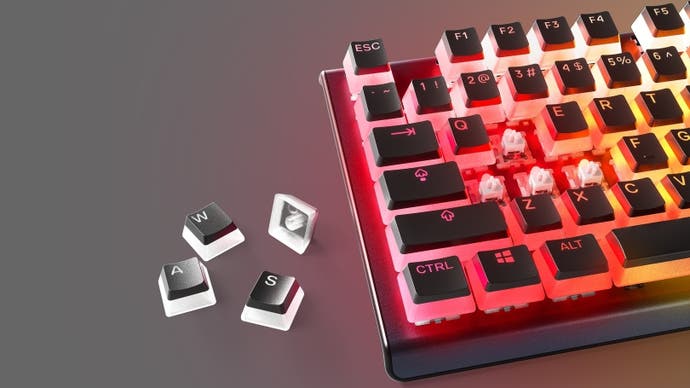Best gaming keyboard 2024: Digital Foundry's picks
Leading mechanical and non-mechanical keyboards tested.
Choosing the right PC gaming peripherals can make a world of difference, by making it easier to survive in competitive games or simply become immersed in your favourite virtual world for hours on end. We've already covered the best gaming mice and gaming headsets, and now it's time to take a closer look at another critical area: the best gaming keyboards.
Whether you prefer a simple non-mechanical keyboard that nails the essentials or a full-fat mechanical option that brings all of the best features too, you're sure to find something that appeals within our top recommendations. With a bit of luck, you'll find some great new brands and keyboards here that you may not have even heard of, let alone considered.
We've also collected Frequently Asked Questions at the bottom of the page, like what kinds there are, the differences between mechanical and not, and why some keyboards look funny.
Why take my word for it?
I've exhaustively tested each of the keyboards on this list - and many more that didn't make the cut. I've been reviewing gaming keyboards since 2010, from the rebirth of the mechanical keyboard to the uniquely aesthetic examples with novel switches and crazy features hitting the market as we continue into the halcyon days of 2024. It can be hard to keep up with the rapid pace of innovation in this unassuming space, so let me be your guide.
Of course, it goes without saying that while there are certainly better and worse keyboards on the market, choosing the right keyboard is also a very personal experience. We've tried to consider a range of viewpoints and value judgements, but my number one choice might be one you wouldn't even consider.
With that out of the way, let's get straight to the top picks. Click the links below to jump straight to those entries, or scroll on to read our full recommendations!
Best gaming keyboard 2024
- Corsair K100: a full-fat mechanical with truly unique features
- SteelSeries Apex Pro: a beautiful design with plenty of extras
- Nuphy Halo96: a compact full-size layout with impeccable aesthetics and typing feel
- SteelSeries Apex 3 TKL: the best membrane keyboard available
- Keychron K3: a compact and low profile optical switch keyboard
- Fnatic Streak80 LP: a beautifully-designed low profile TKL keyboard
- SteelSeries Apex 9 TKL: an incredible optical switch keyboard with a faultless design
- Trust GXT 867 Acira: a great budget mechanical keyboard
- Logitech G Pro X TKL Lightspeed: a rare premium wireless mechanical gaming keyboard
- Ducky One 3: superior key feel, simple yet evocative design
- Trust Gaming GXT 856 Torac: the best cheap membrane keyboard
- Whirlwind FX Atom: a cheap compact keyboard with advanced RGB
1. Corsair K100
A full-fat mechanical with truly unique features

- Full-size with dedicated media controls, volume wheel and multi-function wheel
- Cherry MX Speed or OPX optical mechanical switches, ideal for gaming
- Best-in-class software for recording macros, rebinding keys and adjusting RGB lighting
Corsair has a proud history of creating all-out mechanical keyboards with features that other manufacturers wouldn't be able to copy for years, starting with the K90 way back in 2011 and K95 in 2014 - and now we've finally gone to the next tier with the £230/$200 Corsair K100. If you've used a high-end Corsair mechanical keyboard, the K100 is a logical evolution that adds on a surprisingly-capable multi-function wheel while taking specs and features to new heights.
Like the K90 and K95, the K100 is a full-size keyboard with a num-pad, plus a dedicated column of macro keys on the left, media keys on the right and a volume wheel in the upper right corner. What's new for the K100 is that second wheel in the upper left, which can be used for tons of different things - zooming in and out, scrolling vertically or horizontally, skipping tracks, launching programs, swapping apps and so on. You can press the button in the centre to switch between different functions, with a different colour denoting each mode. Everything can be customised in the company's iCUE software, which remains the most comprehensive tool available for tweaking lighting effects, recording macros and rebinding keys. Corsair also owns Elgato, so expect tight integration with products like the Stream Deck as well.
Aside from the wheel, the K100 offers other noticeable improvements over its predecessors. The new optical OPX switches feel great under the finger, with a pleasant report and near-instant recognition, thanks to the lack of a debounce delay and 4000Hz polling, and you can go for a Cherry MX Speed alternative if you prefer. The lighting effects look as good as ever, with rainbows shooting out of each key, the logo and new side channels too.
Overall, it's easier to list off what the Corsair K100 can't do than what it can do. If you have the desk space for a full-size-and-then-some keyboard and you'll actually use its many many features, then the K100 is worth every penny of its premium asking price.
2. SteelSeries Apex Pro / Apex Pro TKL
This keyboard boasts hyper-advanced features while still nailing the essentials
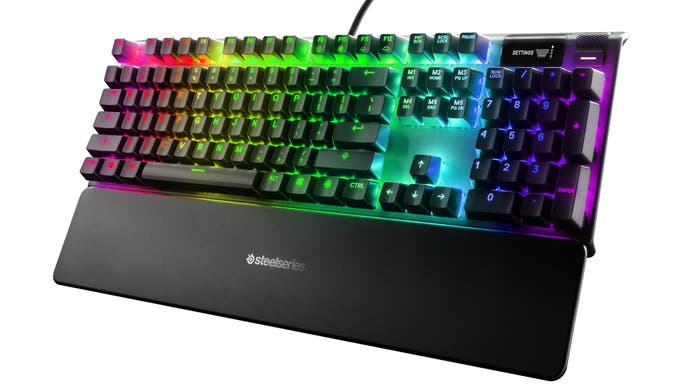
- Adjustable actuation switches can be tuned for gaming or typing
- Bright RGB backlighting and beautiful design with a super extra OLED display
- Superb build quality and long feature list justifies the premium price
The £169/$150 SteelSeries Apex Pro is our new runner-up pick, thanks to its strong fundamentals and truly meaningful extras. The first thing you're likely to notice is the OLED screen in the upper right, which allows you to see your in-game stats, chatters in Discord or the music you're playing; it also lets you adjust settings using the convenient volume wheel nearby. This feature even makes it into the smaller TKL (tenkeyless) version, though the volume wheel is substantially thinner.
Less obvious but more impressive are the magnetic sensors built into each switch, which allow the actuation point - the point at which a keypress is registered - to be set anywhere from a crazy-short 0.4mm to a super-deep 3.6mm. This lets you reap the responsiveness benefits of a "speed switch" keyboard for gaming, then swap back to a more standard feel for typing and general computer use with a push of a button. It sounds trite, but this really is like having two keyboards in one.
As well as offering advanced features, the Apex Pro is just a nice keyboard to look at and to use. It feels well built, with an gently rounded aluminium alloy frame, and its bright RGB backlighting spills out of the large capital letters on each keycap. A USB pass-through port, elegant cable routing, intuitive companion software and a comfy palm rest complete the package.
The ABS keycaps included in the box are fine, but SteelSeries also make Prismcaps - double-shot PBT keycaps in white or black that provide an even cooler look. These offer a slightly more textured matte finish and look fantastic, transitioning from opaque at the top to translucent further down. These keycaps can be used with other mechanicals too, so they're worth picking up for any board that comes with cheap or boring keycaps. Alternatives exist from other brands too, under names like 'pudding caps'.
3. Nuphy Halo96
A compact full-size layout with impeccable aesthetics and typing feel
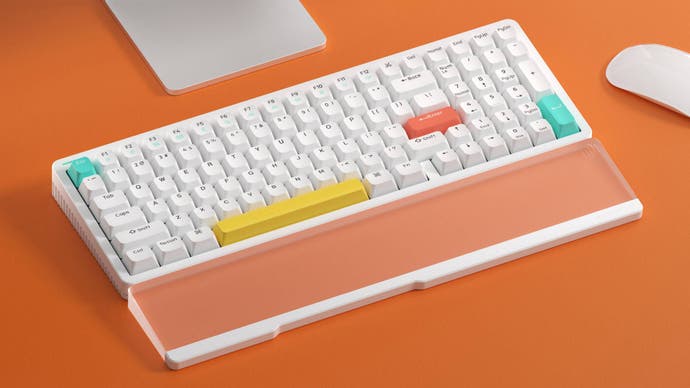
- Stylish full-height design in black or white
- Great switch options that will suit almost anyone
- Compact despite the full-format layout with numpad
The Nuphy Halo96 wireless mechanical keyboard is a fantastic choice for gaming or working, with a compact full-size ANSI/US layout, a beautiful colour scheme in white or black, optional RGB back/edge-lighting and full Mac/Windows compatibility with wired and wireless connectivity. The keyboard is supremely built, with a high-profile unibody aluminium frame, and feels incredible given its reasonable £122/$126 price point (with code DF10).
I particularly enjoyed the feel of this keyboard with the Rose Glacier switches installed, which provide a much more noticeable tactile response than standard MX Brown tactile switches - great for typing, but also ideal for RTS and other genres where key accuracy is critical.
The keyboard is hot-swappable and can be purchased with plenty of other interesting switch options too, from more standard G Pro Red and Brown switches to pre-lubed Night Breeze, Baby Raccoon and Baby Kangaroo options. All of these choices benefit from a special silenced space bar and layers of silicone to produce soft, deep and eminently satisfying typing sounds.
Overall, the Halo96 is a fantastic board, especially when paired with the acrylic/aluminium wrist rest shown above. This looks almost like glass, diffusing the edge RGB throughout the wrist rest and making the keyboard comfier to use too.
Nuphy also makes the Halo75 and Halo65, which offer the same excellent design in a smaller form factor and at a slightly lower price. We also recommend their low-profile Air75 keyboard.
4. SteelSeries Apex 3 TKL
The best non-mechanical membrane keyboard we've tested
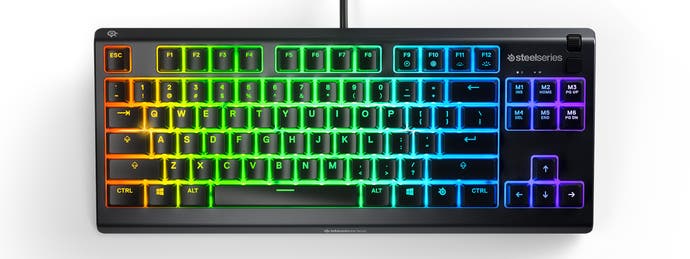
- Membrane keys provide a soft, quiet feel perfect for shared spaces
- Eight-zone RGB lighting is bright and effective
- Key rollover remains a limitation for membrane keyboards
If you prefer the softer feel, quieter operation and lower cost of non-mechanical keyboards, the £38/$36 SteelSeries Apex 3 TKL is the best we've tested so far. The membrane switches offer a decent amount of tactile feedback but require a relatively strong touch compared to mechanical keyboards. Like the Roccat Magma, our previous pick, RGB LEDs shine through a layer of semi-frosted plastic, diffusing the light evenly across the keyboard, which looks great. The membrane keys are also water and dust resistant, with an IP32 rating that means they should survive a few spills - although something like sweetened tea or cola will probably gum up the works somewhat.
In terms of extra features, this tenkeyless keyboard has a rare volume wheel in the upper right and a button that's set to play/pause by default. This can be customised in the SteelSeries GG software, which also allows different lighting modes and key assignments.
However, the keyboard does have one major disadvantage. Despite claiming "gaming-grade anti-ghosting technology", the keyboard doesn't offer as high a key rollover count as we'd expect. For example, with Q and W held down, you can't press down 0, H, J, comma or period. This means the keyboard only has a rollover count of two (2KRO), and six is the standard for a good gaming keyboard. Sadly, this is often a downside to choosing membrane over mechanical, and is worth bearing in mind if you are a fast typer or play games that require a lot of simultaneous key presses (like rhythm games or co-op games with two players on a single keyboard).
5. Keychron K3
A compact and low profile optical switch keyboard
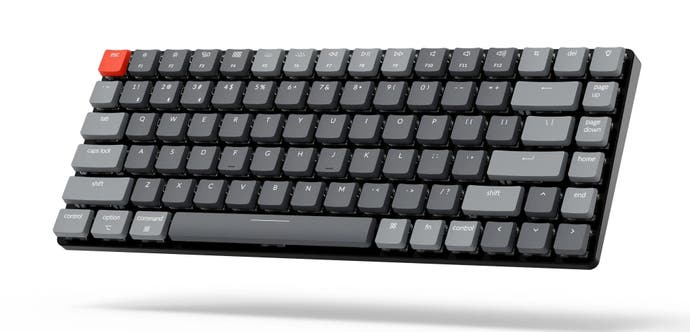
- Low profile optical switches in linear, tactile or clicky variants
- Minimalist, portable and Mac-friendly design with detachable USB-C cable
- Incredibly affordable for an optical switch keyboard
The £89/$84 Keychron K3 proves that you don't need to spend a lot to get a beautiful keyboard, modern features and excellent build quality. The K3 uses rare low profile optical mechanical switches, with a choice of clicky, tactile or linear options. These, combined with the compact 75 percent layout, make for a typing experience akin to the best laptop keyboard you've ever used.
The optical sensor built into each switch ensures key presses can be registered in an instant, equalling the responsiveness of much more expensive gaming keyboards like the Razer Huntsman TE we featured in a previous version of this article. Keychron's optical switches are also hot-swappable, making it easy to replace a broken switch or change to an entirely different feel later on. (If you're not sold on optical switches, then you can get regular Gateron low profile switches instead for a slightly lower cost, but note that these aren't hot-swappable.)
As well as performing well in games, the K3 is also one of the few Mac-friendly keyboards on the market, with both Mac and Windows keycaps available. If you ever have occasion to use a Mac, you'll no doubt appreciate the hotkeys along the top row of the keyboard and the alternate Mac modifier keycaps. The keyboard should be used via USB-C for competitive gaming, but Bluetooth is also available with around 30 hours of battery life - so you can use it comfortably with the iPhone and iPad, in addition to a wide range of other computers and mobile devices.
All in all, the Keychron K3's compact size, excellent switches and overall aesthetic makes it one of our favourite keyboards for gaming or typing. This keyboard is also uniquely in-demand here at Digital Foundry's Bristol office, and disappearing on many occasions because someone fancied using it for work. If that's not a tacit recommendation, I don't know what is!
6. Fnatic Streak80 LP
A beautifully-designed low profile TKL keyboard
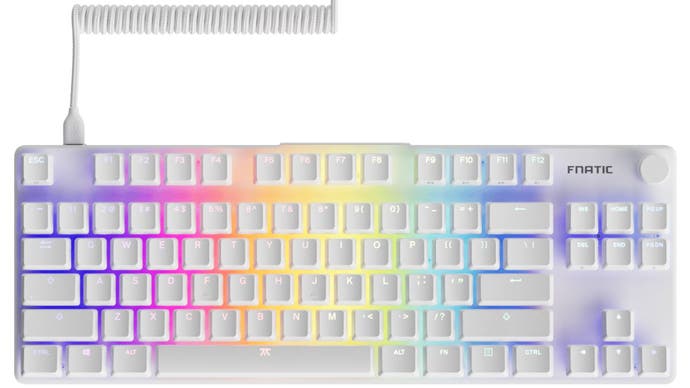
- Streamlined low profile TKL design with volume wheel
- High-quality PBT keycaps atop lubed switches and stabilers with insulating foam
- Coiled USB-C cable for extra rizz
The £125/$130 Fnatic Streak80 LP is one of those keyboards that you plug into your computer and instantly fall in love with, thanks to its sleek and gently rounded design, strong RGB and fancy coiled USB cable. This keyboard just looks a million bucks - and it feels fantastic too, with Fnatic catching up with mechanical keyboard trends with lubed switches and stabilisers, insulating foam and premium-feeling PBT keycaps. These make for a great-sounding keyboard as well, with the low profile linear switches feeling smooth and producing a deep clatter.
For gaming, the Fnatic keyboard doesn't include the 2000Hz or higher polling rates found in some competitively-minded options, nor the optical/analogue switches that unlock the trendy rapid trigger technology preferred by some FPS players and popularised by the Wooting 60 HE. Similarly, only a US ANSI layout is offered, evidence of what I imagine is quite a limited production compared to giants like Corsair, Razer and SteelSeries, and the switches aren't hot-swappable which may disappoint some enthusiasts.
Still, this is a comfortable high-performance keyboard for competitive play and without a doubt the finest low profile gaming keyboard we've ever tested.
7. SteelSeries Apex 9 TKL
An incredible TKL keyboard with optical switches and a faultless design

- Superior design, fitting a volume knob onto a compact TKL frame
- High performance optical linear mechanical switches
- Refined appearance, with strong RGB backlighting
The £100/$93 SteelSeries Apex 9 TKL offers a compact yet comfortable TKL layout, fast yet distinctly mechanical switches, a volume wheel and strong backlighting.
The nice-to-haves are in place too - a fairly strong build with an aluminium-topped chassis, a detachable USB-C cable and premium-feeling PBT keycaps. It also has SteelSeries' OptiPoint optical switches, which reduce input lag and allow for an adjustable actuation point between 1.0mm and 1.5mm. The 1.0mm setting is intended for gaming and does feel a bit more responsive, but also makes it easier to accidentally press a key when writing, so I tend to keep it on the 1.5mm setting. The switches are also hot-swappable, so you can change for different switches or replace broken ones - although the outlay for this is substantial, at £39 for the three packs of 35 switches each required. There's even a keycap puller concealed in the underside of the keyboard, though I wish it had the ability to remove switches too.
Overall, a strong alternative to the Streak80 LP for those that prefer full-height switches and keycaps.
8. Trust GXT 867 Acira
A great budget mechanical keyboard
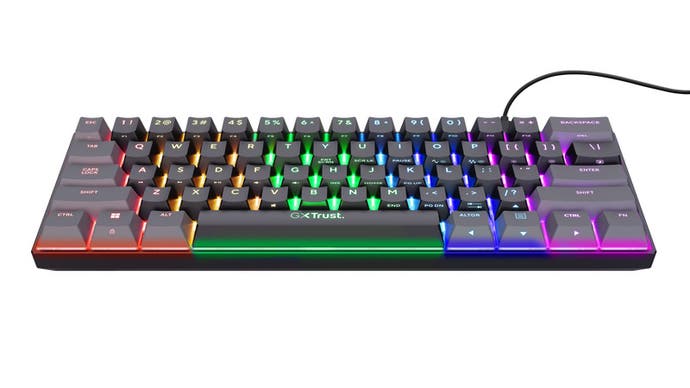
- Nice grey/black design with RGB backlighting
- Proper UK layout mechanical keyboard
- Affordable price only felt in a few areas
The £40 Trust GXT 867 Acira is one of the best keyboards I've ever tested at its price point, offering a surprisingly stylish design, full RGB backlighting and a proper UK layout in the 60 percent form factor. With real mechanical switches, you get a lot of advantages over the membrane keyboards that are more common at this price, including a more precise key feel that doesn't degrade over time, upgrade potential, repairability and full n-key rollover (NKRO)*.
*NKRO means the keyboard can recognise an unlimited number of simultaneous keypresses, handy for FPS and rhythm games. Many membrane keyboards, by comparison, have 2KRO - so if you have two keys pressed down already, a third may not be registered.
There are cutbacks to make this price possible - including budget Outemu Red switches, which don't feel as precise as those made by other brands - but the core gaming experience is certainly intact; I'd much rather have a budget mechanical than a high-end membrane. You could also make the case that the ABS keycaps could be upgraded later for fancier PBT alternatives, but you're likely to pay a significant percentage of the purchase price to get something that's a genuine improvement over what's provided.
I'm surprised just how good this keyboard is for the money. It may not have fancy features like rapid trigger or a high polling rate, but for actually playing games it does everything you need.

The 60 percent layout of the Acira may be limiting for some people, including those that rely on their keyboards for work as well as gaming, so it's worth mentioning that a full-size alternative is also available: the £60 Trust GXT 866 Torix, which we also recommend. This larger keyboard is also fancier, with an aluminium top plate, snappier Huano switches, low profile keycaps and a volume wheel. It's hard to argue with styling remiscient of Logitech's G815 and G915 at a third of the price!
9. Logitech G Pro X TKL Lightspeed
A rare premium wireless mechanical gaming keyboard
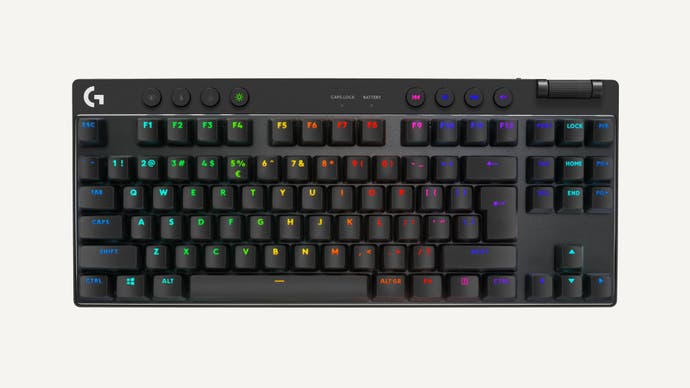
- Bulletproof Lightspeed wireless, plus USB and Bluetooth
- Attractively-designed and robust board in multiple colours with good added features
- Synchronises nicely with other Logitech peripherals in G Hub
- Expensive, though a cheaper wired alternative is also available
Logitech's keyboards are a mainstay on esports stages worldwide, thanks to the company's sponsorship of some seriously high-profile esports teams, but the £199/$190 Logitech G Pro X TKL Lightspeed is well worth choosing even if you're not at that level (yet).
This keyboard takes design cues from the popular G915, including that keyboard's wide volume roller and additional (non-mechanical) keys above the function row for adjusting connectivity, lighting, game mode, media and volume. Unlike the G915 though, this is a full-height keyboard with Logitech's own GX switches made in the familiar Cherry mould, giving each keypress greater travel and allowing for more tactile and/or clicky feedback. PBT keycaps are provided, though they're a little slicker than some others I've tried recently, and the typing feel as a whole does perhaps lack modern innovations like pre-lubed switches and stabilisers, sound-dampening foam and other elements that are making their way from enthusiast to mainstream mechanical keyboards.
The keyboard is unusual in that it's a competition-focused wireless keyboard, using the same quick and reliable Lightspeed connection as the company's mice and headsets. You do pay a lot for that extra functionality, but perhaps the flexibility it affords - alongside higher-latency, wider-compatibility Bluetooth - makes the higher price worth it. It even comes with a beautiful carry case for taking to LANs.
Similarly, you get a good software solution in the form of G Hub for programming macros, remapping keys and adjusting the lighting, and there's a good argument to sticking in one ecosystem - and with Logitech's traditional mice and headset strengths, this is a good complementary keyboard pick despite its high price. For a cheaper wired alternative, consider the £70/$110 Logitech G Pro keyboard.
10. Ducky One 3
Superior key feel, simple yet evocative design

- A clean design with high-quality components like PBT keycaps and silicone/foam dampening
- 60 percent, TKL and full-size UK layouts available
- Hot-swappable sockets with Cherry MX switches
The £120/$119 Ducky One 3 Classic TKL is a brilliant keyboard, offering a clean and simple design with a few nice flourishes - including swoopy bezels, an optional Year of the Tiger spacebar and a coloured enter key. The key feel here is excellent, thanks to Cherry MX switches (hot-swappable), silicone and foam dampening and PBT keycaps, which goes some way to justifying the high price.
Otherwise, you get a solid but not exceptional feature list, with a detachable USB-C cable, bright per-key RGB lighting, n-key rollover, three-level feet and a comprehensive Function layer. You could certainly find cheaper keyboards with more features - like analogue switches, additional macro keys, volume rollers, wrist rests - but for actual gaming and typing, I'd probably go for the keyboard that truly nails the essentials. Note that the One 3 is also available in 60 percent and full-size sizes.
11. Trust Gaming GXT 856 Torac
The best cheap membrane keyboard
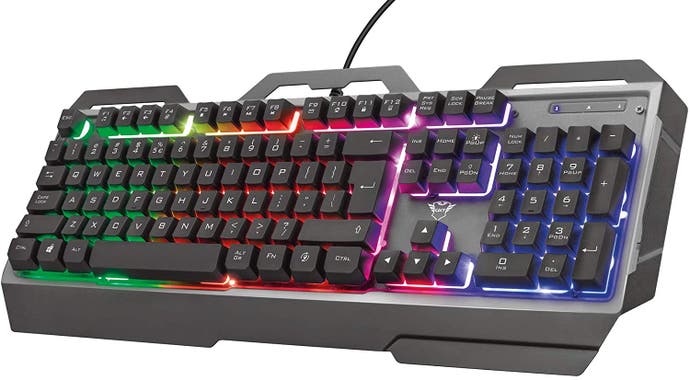
- Metal construction and very gamer-y RGB look
- Very affordable, but only available in the UK and Europe
- RGB backlighting isn't customisable
Membrane keyboards get a rap from mechanical keyboard fans, but some people just prefer the soft feel of a classic rubber dome board and there's no denying that membrane boards can be a lot cheaper too. If that's you, then a good inexpensive option to consider is the £18 Trust Gaming GXT 856 Torac. The Torac offers a clear contrast against monochrome and rectangular office keyboards, with bright RGB backlighting and a metal frame that extends beyond that is strictly necessary. The labels on each key are easy to read, while a Function layer allows convenient access to media and volume controls. One potential gotcha is that the lighting here isn't customisable, so you can't set the keyboard to a single colour - each key will always light up in the same colour, unless the lighting is turned all the way down. Older users may prefer something a little more refined, but for the younger audience this keyboard seems to be pitched towards the Torac will do the job nicely.
12. Whirlwind FX Atom
A compact 60 per cent size keyboard with advanced RGB
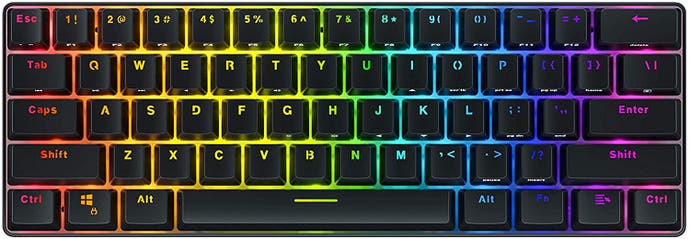
- Powerfully programmable RGB backlighting
- Compact 60 per cent size is convenient for gaming
- Available with red (linear), blue (clicky) or brown (tactile) Gateron switches
The Whirlwind FX Atom is a unique 60 per cent mechanical keyboard. The keyboard's design and specifications are impressive for the bargain basement price ($30), with front and top-labelled double shot ABS keycaps, a rare 3000Hz polling rate which can slightly reduce input delay and a detachable USB-C cable. The software is perhaps the most interesting feature, with Whirlwind FX claiming to offer lighting integrations for more than 50 games, and a kind of online marketplace that allows you to download or share user-made effects. The community feels a little small right now, but it's a cool idea and the keyboard is a delight, so I hope we see it grow steadily over the time. After all, the more people contributing, the better the Atom will be able to deliver on its latent promise.
Frequently questioned answers
What's better, mechanical or non-mechanical?
It depends! Mechanical keyboards feel better to type or game on for many people, and are sometimes described as faster or more responsive. While membrane keyboards harden over time, mechanical keyboards provide a consistent experience for decades. Mechanical keyboards are also available in many different switches, each of which has their own characteristics - loud versus quiet, tactile versus linear, long travel versus short travel and so on.
However, mechanical switches are expensive to produce and often sound louder than their non-mechanical counterparts. By comparison, non-mechanical keyboards tend to feel softer, cost less to produce and don't sound as loud. While both options have their objective strengths and weaknesses, it often comes down to personal preference.
What types of mechanical keyboards are there?
Mechanical keyboards are defined by their switches. The most common options are MX switches, originally made by Cherry and now made by a range of manufacturers. Each switch is described by its colour; the three most popular are as follows:
- Blue: Clicky and tactile, with a relatively high actuation force
- Brown: Not clicky but still tactile, with a relatively low actuation force
- Red: Linear, not clicky or tactile, with a relatively low actuation force
Clicky feedback is fun and can make typing easier, but it can be annoying to others - especially if you're in an shared space or streaming. Tactile feedback also makes it easier to know when a key has been pressed, which can be handy for typing or gaming. Linear switches eschew this added feedback, but operate more smoothly and are therefore most commonly selected for inclusion in gaming keyboards. As usual though, a lot of this comes down to personal preference so experimentation is key.
Since mechanical keyboards became popular about ten years ago, there has been explosion in the numbers of mechanical switches available. Many peripheral producers, such as Razer and Logitech, now make their own proprietary switches which are takes on the original Cherry MX design. The most common modifications allow for faster keypresses (e.g. MX Speed Silver), quieter operation (e.g. MX Silent Red) and improved RGB backlighting (e.g. MX RGB Red). We've also seen the introduction of more major redesigns, such as including optical sensors in order to offer adjustable actuation points or full-fat analogue switches as in the Wooting One, above. Laptop-style Cherry ML switches are also becoming a thing.
What types of non-mechanical keyboards are there?
There are quite a few options, with the most common being traditional membrane keyboards that use a dome of rubber beneath each key to let you know that your key press has been recognised. Hybrid switches, sometimes described as 'mecha-membrane', attempt to provide additional tactile feedback, similar to a mechanical switch, without giving up the low cost and soft feel of a membrane. Scissor switches are another option, which provide a little more tactile feedback and a short travel distance, like you'd expect to find on a laptop.
What is the point of keyboards that don't include the number pad?
Many keyboards, particularly mechanical ones, don't include the number pad. This might be done for several reasons: to lower manufacturing costs by reducing the number of expensive mechanical switches included, to save space on crowded desks or to create a more portable design. However, the most important benefit of so-called 'tenkeyless' designs is that of ergonomics: with no number pad, right-handed gamers can keep their mouse hand more in line with their arm. This position is easier to maintain over long periods - although regular breaks are always advised! - and puts less stress on the limbs and joints. There are also even more compact designs, i.e. 60% or 75%, which drop more keys in order to achieve even smaller sizes.
Are there quiet mechanical keyboards?
Yes. There are many keyboards on the market made with MX Silent Red switches, including options from Corsair, Fnatic and others. Some popular examples include the Fnatic Gear Rush, Fnatic MiniStreak, Corsair Strafe and Corsair K70 Lux; these keyboards and other quiet mechanical keyboards are linked below. However, no keyboard is completely silent, and these are no exception!
Why do some keyboards have differently shaped Enter and Shift keys?
In short, there are two major keyboard layouts in the world: ANSI for the US, China and some other regions, and ISO for the UK, much of Europe and most other countries. ANSI features a wide left Shift key and a wide Enter key, while ISO instead uses a thin left Shift key and a tall Enter key. If a keyboard's layout looks unfamiliar, this might be why.
Regardless of which layout you're used to, you can learn to use the alternate layout without too much difficulty as your computer's keyboard layout setting overrides what is printed on each keycap - so pressing AltGr + 4 on a US keyboard on a British computer will result in the '€' symbol as normal. While most mainstream gaming keyboards come in both layouts, some keyboards are only available in one or the other - and often, it's Europeans that have to accept an American layout. This can be annoying at first, but it does allow you to consider a much wider range of keyboards.
